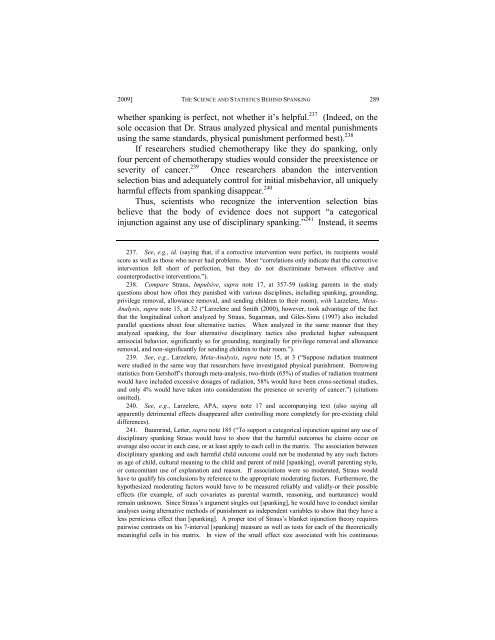The Science and Statistics Behind Spanking Suggests that
The Science and Statistics Behind Spanking Suggests that
The Science and Statistics Behind Spanking Suggests that
Create successful ePaper yourself
Turn your PDF publications into a flip-book with our unique Google optimized e-Paper software.
11-FULLER_FINAL_AFTERPROOF.DOC 2/17/2009 8:50 AM<br />
2009] THE SCIENCE AND STATISTICS BEHIND SPANKING 289<br />
whether spanking is perfect, not whether it’s helpful. 237 (Indeed, on the<br />
sole occasion <strong>that</strong> Dr. Straus analyzed physical <strong>and</strong> mental punishments<br />
using the same st<strong>and</strong>ards, physical punishment performed best). 238<br />
If researchers studied chemotherapy like they do spanking, only<br />
four percent of chemotherapy studies would consider the preexistence or<br />
severity of cancer. 239 Once researchers ab<strong>and</strong>on the intervention<br />
selection bias <strong>and</strong> adequately control for initial misbehavior, all uniquely<br />
harmful effects from spanking disappear. 240<br />
Thus, scientists who recognize the intervention selection bias<br />
believe <strong>that</strong> the body of evidence does not support “a categorical<br />
injunction against any use of disciplinary spanking.” 241 Instead, it seems<br />
237. See, e.g., id. (saying <strong>that</strong>, if a corrective intervention were perfect, its recipients would<br />
score as well as those who never had problems. Most “correlations only indicate <strong>that</strong> the corrective<br />
intervention fell short of perfection, but they do not discriminate between effective <strong>and</strong><br />
counterproductive interventions.”).<br />
238. Compare Straus, Impulsive, supra note 17, at 357-59 (asking parents in the study<br />
questions about how often they punished with various disciplines, including spanking, grounding,<br />
privilege removal, allowance removal, <strong>and</strong> sending children to their room), with Larzelere, Meta-<br />
Analysis, supra note 15, at 32 (“Larzelere <strong>and</strong> Smith (2000), however, took advantage of the fact<br />
<strong>that</strong> the longitudinal cohort analyzed by Straus, Sugarman, <strong>and</strong> Giles-Sims (1997) also included<br />
parallel questions about four alternative tactics. When analyzed in the same manner <strong>that</strong> they<br />
analyzed spanking, the four alternative disciplinary tactics also predicted higher subsequent<br />
antisocial behavior, significantly so for grounding, marginally for privilege removal <strong>and</strong> allowance<br />
removal, <strong>and</strong> non-significantly for sending children to their room.”).<br />
239. See, e.g., Larzelere, Meta-Analysis, supra note 15, at 3 (“Suppose radiation treatment<br />
were studied in the same way <strong>that</strong> researchers have investigated physical punishment. Borrowing<br />
statistics from Gershoff’s thorough meta-analysis, two-thirds (65%) of studies of radiation treatment<br />
would have included excessive dosages of radiation, 58% would have been cross-sectional studies,<br />
<strong>and</strong> only 4% would have taken into consideration the presence or severity of cancer.”) (citations<br />
omitted).<br />
240. See, e.g., Larzelere, APA, supra note 17 <strong>and</strong> accompanying text (also saying all<br />
apparently detrimental effects disappeared after controlling more completely for pre-existing child<br />
differences).<br />
241. Baumrind, Letter, supra note 185 (“To support a categorical injunction against any use of<br />
disciplinary spanking Straus would have to show <strong>that</strong> the harmful outcomes he claims occur on<br />
average also occur in each case, or at least apply to each cell in the matrix. <strong>The</strong> association between<br />
disciplinary spanking <strong>and</strong> each harmful child outcome could not be moderated by any such factors<br />
as age of child, cultural meaning to the child <strong>and</strong> parent of mild [spanking], overall parenting style,<br />
or concomitant use of explanation <strong>and</strong> reason. If associations were so moderated, Straus would<br />
have to qualify his conclusions by reference to the appropriate moderating factors. Furthermore, the<br />
hypothesized moderating factors would have to be measured reliably <strong>and</strong> validly-or their possible<br />
effects (for example, of such covariates as parental warmth, reasoning, <strong>and</strong> nurturance) would<br />
remain unknown. Since Straus’s argument singles out [spanking], he would have to conduct similar<br />
analyses using alternative methods of punishment as independent variables to show <strong>that</strong> they have a<br />
less pernicious effect than [spanking]. A proper test of Straus’s blanket injunction theory requires<br />
pairwise contrasts on his 7-interval [spanking] measure as well as tests for each of the theoretically<br />
meaningful cells in his matrix. In view of the small effect size associated with his continuous

















